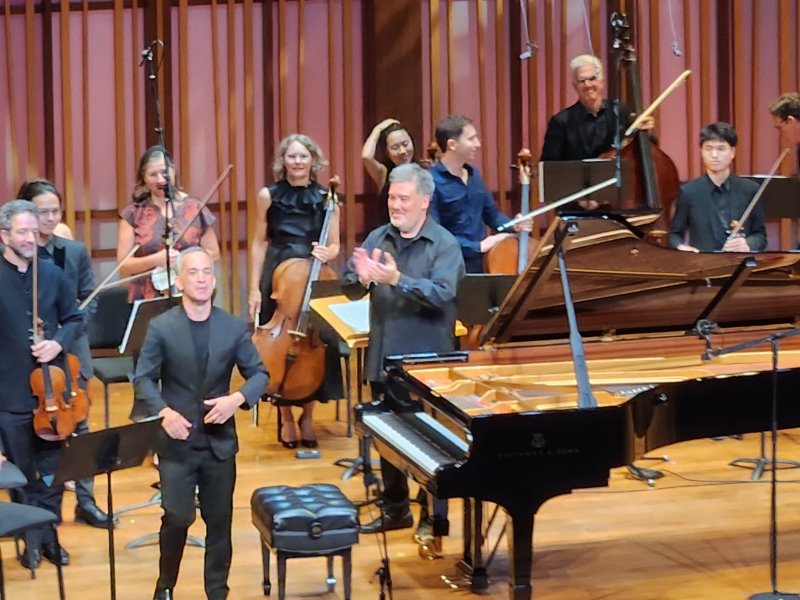Review: THE LA JOLLA MUSIC SOCIETY'S SUMMERFEST OPENING at The Baker-Baum Concert Hall
Expect the Unexpected

La Jolla Music Society's Summerfest season began as an unannounced hidden quintet offered a set of brass calls from a suite of 17th Century dances by Thomas Simpson. Since I’d never even heard of him, I only know that because ushers handed out a program list three hours later as the audience left the Conrad. Thank goodness I didn’t have to decipher my handwritten notes!
“Expect the unexpected” was Music Director Inon Barnatan’s only explanation when he appeared to tell us what we’d just heard and introduce the evening’s first performers as they entered from their hiding place stage left. They then proceeded to play the equally obscure Canzon 22 by Bastian Chelise who, according to the subsequently supplied program notes, “died, probably in Vienna sometime after 1608.”
Though obscure, both composers had mastered the glorious brass sounds of the 17th Century more often heard in the scores of Giovanni Gabrieli. The musician’s warm regal strength had me looking forward to more of the unexpected.
The remaining three orchestra sections displayed their own considerable talents accordingly, though their unexpected pieces were all in the more familiar styles of the 20th Century. The first was a little known and surprisingly light-hearted set of three bagatelles for wind quintet by the usually seriously forbidding György Ligeti. Ligeti is best known for Atmosphères, a dense, mysterious piece director Stanley Kubrick used to chilling effect in 2001: A Space Odyssey. On this evening we heard Ligeti in the spirit of delightful wind pieces by Poulenc. The quintet dug into the bagatelles, their enjoyment obvious in facial expressions and rhythmic body movements. Bassoonist Eleni Katz, clad in a full-length red dress, was swinging her somewhat ungainly instrument as though on the stand at Birdland.

Percussion was up next. Though several rhythm instruments were on the stage, percussionists Dustin Donahue and Sidney Hobson introduced the concept behind minimalist Steve Reich’s Clapping Music, then were joined by half a dozen other musicians, including Barnatan, for several minutes of, what else, perfectly in unison clapping based on Flamenco ryhthms. Reich’s endless repetition with subtle changes for the attentively expert ear, or perhaps one succumbing to their potentially hypnotic effect, has never appealed to me. I confess that even the better-known minimalist music of Philip Glass drives me crazy. But, in the context of the unexpected, the brief Clapping Music was fun for both performers and the audience.
And the cleverly chosen next piece for strings also brought smiles from both ends of the concert hall because few in the audience would have known that the modern Ukrainian composer Dmitri Klebanov based the first movement of his fourth string quartet on a Ukrainian folk song rather than the joyous “Carol of the Bells”, which itself is an arrangement of the same folk song.
The duo of violinists Blake Pouliot and Steven Copes continued in the same vein with Bruce Dukov’s effectively playful arrangement of Sousa’s marching-band classic “Stars and Stripes Forever.”
The first half ended in a more serious mood with Franz Schreker’s Chamber Symphony and the first appearance of conductor Alan Gilbert, music director of the New York Philharmonic from 2009 to 2017. The symphony, with a single movement of roughly 25 minutes, is a master class in orchestral color from its fairy-tale-like beginning with flute, harp, celeste and shimmering strings to energetic forte climaxes for the full chamber orchestra. In terms of complexity, the somewhat neglected work is light years away from a cappella clapping. Gilbert provided expert guidance to its changing textures as frequent sudden shifts in rhythm, and dynamics transform melodic content, though the strings could occasionally have added a bit more lushness to the symphony’s many warm late Romantic-era passages.
The second half of the program opened with excerpts from a piece Ligeti may have had in mind when he wrote his bagatelles. Le revue de cuisine (The Kitchen Revue) by Bohuslav Martinu is a wind quintet with piano added, a sassy piece written for a one-act ballet with an absurd plot. In a Shakespearian love triangle, Pot and Lid encounter the libertine tempter, Twirling Stick. Does marriage survive temptation? (Spoiler, it does, though perhaps not until the hero has battered the villain.) Once again the winds were all in with an enthusiastic embrace of a piece heavily influenced by 1920s jazz.
The final piece on the program was the most often heard, but Shostakovich’s first piano concerto is unusual in three ways. It was written for piano and strings rather than full orchestra, features a trumpeter as a second major soloist, and is one of the composer’s few compositions that don’t seem to mirror the tragedy of World Wars, conflict with the Stalin regime and his consistently poor health. Written in 1933, the piece is another example of the influence of 20s jazz on classical composers. Any doubt was disposed of when Shostakovich wrote two jazz suites a few years later.
Barnatan was the pianist and Brandon Ridenour the trumpeter. I assume a breakneck speed was by mutual agreement between them and conductor Gilbert. (I’d have concurred if I’d had a vote). Especially at the speed chosen, the concerto requires a high level of virtuosity, and Barnatan’s playing and enthusiasm were infectious. Ridenour added his own skill, with brilliant punchy staccatos and, in the slow movement, a mellifluous tone and soft vibrato to match the tender beauty of the strings. The finale was full of exuberant youthful confidence--an impertinent exclamation point for a most enjoyable evening of unexpected pleasures.

The La Jolla Music Society's Summerfest has just begun. Visit here for schedule and ticket information.
(Photos Ron Bierman)
Reader Reviews

Videos

